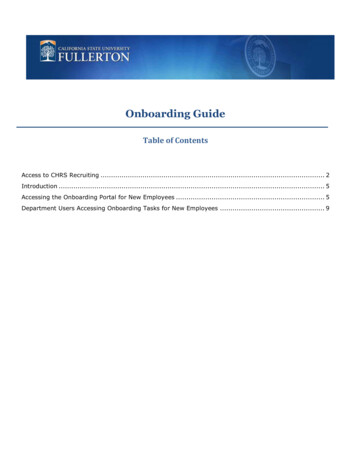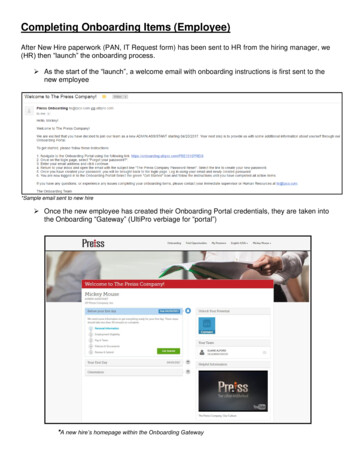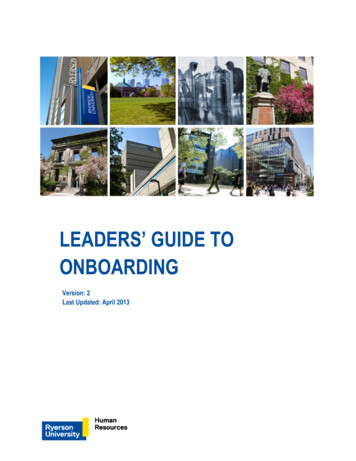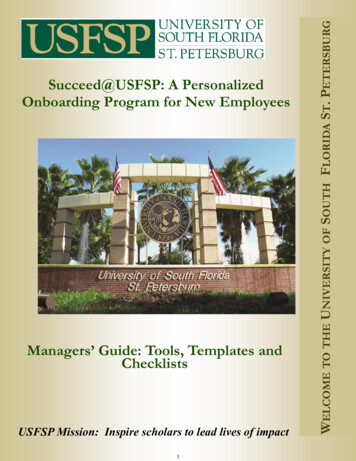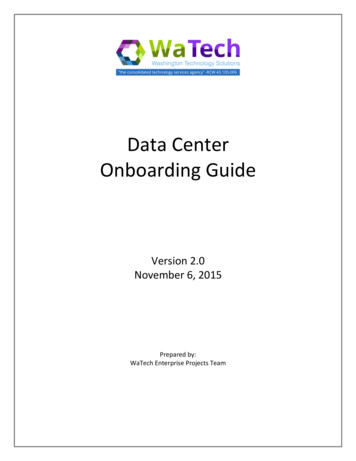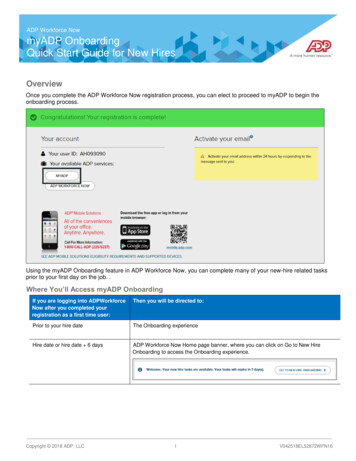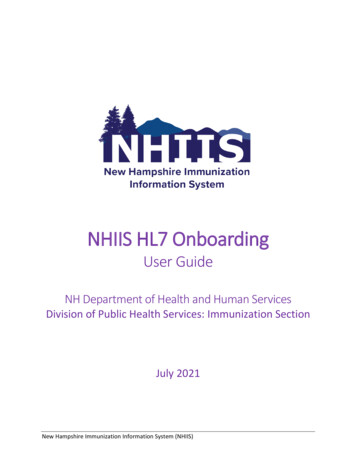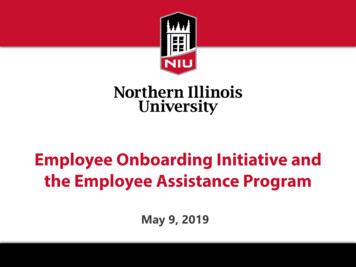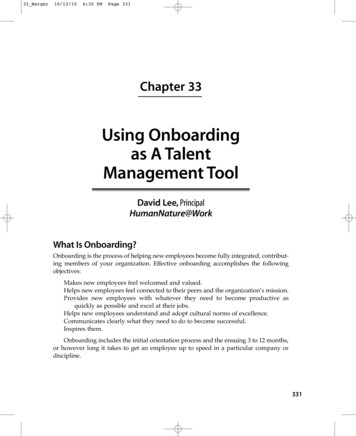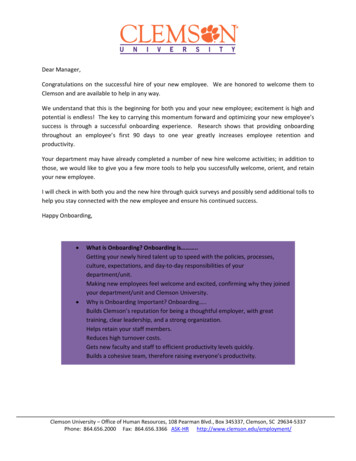
Transcription
Dear Manager,Congratulations on the successful hire of your new employee. We are honored to welcome them toClemson and are available to help in any way.We understand that this is the beginning for both you and your new employee; excitement is high andpotential is endless! The key to carrying this momentum forward and optimizing your new employee’ssuccess is through a successful onboarding experience. Research shows that providing onboardingthroughout an employee’s first 90 days to one year greatly increases employee retention andproductivity.Your department may have already completed a number of new hire welcome activities; in addition tothose, we would like to give you a few more tools to help you successfully welcome, orient, and retainyour new employee.I will check in with both you and the new hire through quick surveys and possibly send additional tolls tohelp you stay connected with the new employee and ensure his continued success.Happy Onboarding, What is Onboarding? Onboarding is .Getting your newly hired talent up to speed with the policies, processes,culture, expectations, and day‐to‐day responsibilities of yourdepartment/unit.Making new employees feel welcome and excited, confirming why they joinedyour department/unit and Clemson University.Why is Onboarding Important? Onboarding .Builds Clemson’s reputation for being a thoughtful employer, with greattraining, clear leadership, and a strong organization.Helps retain your staff members.Reduces high turnover costs.Gets new faculty and staff to efficient productivity levels quickly.Builds a cohesive team, therefore raising everyone’s productivity.Clemson University – Office of Human Resources, 108 Pearman Blvd., Box 345337, Clemson, SC 29634‐5337Phone: 864.656.2000 Fax: 864.656.3366 ASK‐HR http://www.clemson.edu/employment/
ContentsBEFORE THE NEW HIRE STARTSPages 2 ‐ 3Proper administration of this step is critical for both you and your new employee. This checklistprovides some suggestions and ideas for you to begin building a strong connection with yournew employee before their first day of work.MANAGER CHECKLIST FOR NEW EMPLOYEESPage 4This checklist outlines the initial information each new employee should receive. Having bothyou and your new employee sign the checklist, once everything has been covered, helps both ofyou feel confident that necessary information has been shared. In addition, keeping this signedcopy on file provides an excellent record of what information was covered.NEW EMPLOYEE CHECK‐IN MEETINGPages 5 ‐ 6New employee meetings help to establish relationships built on a foundation of trust. A check‐in meeting is designed to quickly address issues. Employee problems usually becomeunsolvable when allowed to go on for too long without intervention.THE BUDDY PROGRAMPages 7 ‐ 9This section outlines responsibilities for the manager and Buddy. Managers are responsible formeeting with the Buddy prior to the new employee’s arrival to discuss expectations of theprogram and to gain commitment on the agreed upon activities. The primary role of the Buddyis to help the new employee feel welcome and comfortable. The activities listed in the BuddyProgram Checklist are suggestions to consider as you get to know the new employee. You playa vital role in helping him/her adjust into the organization.TOP WAYS TO TURN OFF NEW EMPLOYEESPage 10This list not only reinforces what onboarding is all about, it provides a tongue‐in‐cheek way toremind you of your role in the onboarding process.The following indicator appears at the top of various pages in this toolkit. It shows when to use aspecific tool ‐‐ before the new employee arrives, within the first 30 days, 60 days, 90 days andbeyond the 90 day period.NEW EMPLOYEE DAYS 00 – 3030 – 6060 – 9090 1 Page
Before the New Hire StartsNEW EMPLOYEE DAYS 00 – 3030 – 6060 – 9090 Accepting the offer to join the Clemson family was a big decision for the new employee. Oncean employee accepts a position, the days or weeks leading up to that first day are critical inbuilding a positive impression and relationship. The ideas below will help ensure that theconnection you build with your new employee is strong from the start. Orienting a newemployee is a process that can last up to a year, depending on the new employee’s job and hisor her prior experienceSend an official offer letter outlining the specifics of the employee’s new position, including thereporting relationship, salary, etc. For a sample letter go to:http://media.clemson.edu/humanres/sample offer letter.docIf there is a long period of time between the offer and the start date, stay in regular communicationwith your new employee via email or phone. Send a packet of introductory information about theirposition, your department and the University. You can also collect brochures and informationabout University programs and services to send to your new employee to review on his or her owntime.Send an announcement to your department. For examples go to: New Employee AnnouncementMeet with college / division HR liaison to ensure you have necessary paperwork that the new hireneeds to complete.Shortly before the start date, send the new employee an email or letter that includes the following:¾ Date and time to arrive the first day¾ What to bring on the first day; include information regarding documents to verifyemployment eligibility.¾ Location to report to and who to ask for upon arrival¾ Transportation and/or parking information¾ What to expect during the first days on the job (include a schedule of the first few days ifpossible)¾ What to wear¾ Options for lunch (better yet, arrange to take the new employee out to lunch with youand/or a group of colleagues)Set aside time in your calendar to make sure you’re available for the first days and weeks of yournew employee’s tenure.Set up new employee’s workstation, including their desk and / or office, computer, etc. Firstimpressions count, so providing new employees with a clean desk in a cubical or office that is inmove‐in condition will be a positive step in this valuable and new relationship.Set up phone(s): determine if your new employee will need a new phone, or have an existing onereconfigured. Also be sure that their new voicemail box is ready to set up on the first day of work.Make sure necessary supplies are available; plan ahead to ensure that the new employee has all2 Page
required office supplies on their first day of work.Order business cards if necessary / possible. Clemson University has a web‐based orderingprocess.Add new employees to appropriate email lists and calendaring systems.Create a first‐week schedule for new employees so that they have something to do that ismeaningful and helps them hit the ground running. The schedule should include a balance of timewith others, down time, and time on their own to read orientation materials or complete otherorientation‐related tasks. Consider including some of the following:¾ One‐on‐one or small group meetings with other team members. These meetings aretypically designed so that team members can describe their work and how it integrateswith the work the new team member does.¾ One‐on‐one meetings with you to discuss job description, performance expectations,appropriate attire, time and leave, etc.¾ Time to review New Employee Orientation and Benefits Orientation.¾ Meetings with key colleagues across campus.¾ Tour of campusInformation about the buddy assignment.Introduction to the university / college / department website.In addition, if allowed within your department, consider sending the new employee a smallwelcoming gift, such as: A gift related to Clemson (t‐shirt, mug, magnet, book, etc)A gift related to the department or division / college3 Page
Manager ChecklistNEW EMPLOYEE DAYS 00 – 3030 – 6060 – 9090 To Be Filed In Your Departmental Personnel FileEmployee:Department:Supervisor:Emplid:ACTION ITEMS FOR EMPLOYEE View New Employee Online Orientation presentation Attend a scheduled new employee benefits orientation; to schedule your appointment please clickhere. Complete OSHA Mandated Portable Fire Extinguisher Training – Online Training Read and acknowledge electronically the items listed below: Clemson University (CU) Drug and Alcohol Policy AcknowledgementSexual Harassment Policy AcknowledgementOnline Portal Fire Ex nguisher Training Policy AcknowledgementNew Employee Orienta on AcknowledgementFamily Educa onal Rights and Privacy Act AcknowledgementINFORMATION COVERED IN ONLINE NEW EMPLOYEE ORIENTATION Clemson University overview, including vision, goals and strategic priorities.Facts about Clemson UniversityNew Employee Resources, including policies and proceduresRequired paperworkBenefitsDiscounts available to faculty and staff; this is an ongoing project.Getting Around Campus, TigerOne Card Services, Safety and Crime PreventionHealth and Wellness, and Diversity at ClemsonTOPICS TO BE COVERED BY DEPARTMENT / SUPERVISORSupervisors: Check off items as you address them with your new employee. Please send questionspertaining to any of these items to ASK‐HR. Confidentiality Statement Safety / Evacua on Job du es and performance expecta ons Equipment use and access Work schedules, breaks, and over me Telephone use/e que e/voicemail/directory Time and leave repor ng Emergency contact informa on Department / Division / College Org Chart Inclement weather procedures Building use and access / security Email account & usageEmployee’s Signature: Date:Supervisor’s Signature: Date:COPY TO EMPLOYEE4 Page
New Employee Check‐In MeetingNEW EMPLOYEE DAYS 00 – 3030 – 6060 – 90Name:Hire Date:Position:Today’s Date:90 How is your job going?Is the job what you expected when hired?Have you received the necessary training to enable you to succeed in your job thus far?What training would you add?Tell me about your experience with your buddy?What changes if any would you recommend for the buddy program?Do you have the supplies, equipment, tools to perform your job functions?Tell me about your interaction and relationship with your co‐workers?5 Page
Was the online New Employee Orientation presentation helpful?What improvements would you recommend with the New Employee Orientation program?Are there improvements you would recommend for the department orientation?Additional comments:6 Page
The Buddy ProgramA Buddy System is a means of welcoming andencouraging new employees to help them in their firstfew months up to 1 year build a personal connection withClemson University.It’s tough being new. You’re not sure what lies behindeach door: there are enough acronyms and buzzwords tofill a book! These concerns seem insignificant, however,in comparison to the uncertainty of what’s ‘’normal’’ inthe organization—what’s ‘’right’’ and ‘’wrong’’ here?—what’s expected of me?—what’s accepted here?Apprehensions make new employees feel like‘’outsiders’’ .less confident in relating with theircolleagues—senior, peer or junior—and unsure abouthow to act. A “Buddy” can answer questions about thework environment, culture, resources and otherinformation.The specifics of the Buddy Program will vary slightly fromone department to the next. It is the hiring manager’sresponsibility to assign each new employee a Buddy andto effectively communicate the expectations to him/her.Use the New Employee’s Interest sheet to choose abuddy with similar interests and backgrounds. Forexample, if a new employee enjoys hiking, a wise choicefor a Buddy might be someone who also enjoys hiking.When meeting with a prospective Buddy for the firsttime, please use the Buddy Checklist to discuss potentialactivities and gain their commitment.EXPECTATIONS FOR BUDDIES The first week, an introductory meeting is an opportunityto tour the department, introduce colleagues, find theirwork space, and explain the operation of any equipmentor systems they need to start work. Note; be familiarwith the content of the orientation training, so thatinformation is not duplicated.Explain how you can be reached during the day forassistance with anything that materially hinders theirA Buddy can contribute to thesuccess of a newly hired employeeby Scheduling regular contact,such as lunch, coffee, andphone calls Sharing insights about “howthings are done aroundcampus” Discussing why you likeworking here and theClemson culture Answering questions andproviding resourcesWhat is a Buddy?Buddies are colleagues who arewilling to serve as resources fornewly hired employees and helpthem feel connected to the teamby answering questions andprovidingopportunitiestosocialize.Buddies welcome newemployees and: Identifyneedsandanswer , and thefacilitiesAre available for support7 a P a g neweduringemployee’s first year.
work or performance. Make it clear that you are available to them as required, but to leavenon-urgent issues for a scheduled weekly meeting. Make sure you clearly cover rules regardingcontact outside working hours. Ask if the new employee has any questions; then leave the newemployee to get on with the job. Remember: your role is to help the new employee get up tospeed .not to prevent them from doing so.Frequency and Timing of MeetingsAim to meet regularly for at least 30 minutes. This meeting is best held over lunch or in aninformal setting and is used to discuss any non-urgent issues the new employee may have.During the first few days of employment, it is reasonable to expect as many as a half dozenquestions a day; this should tamper down to one or two a day thereafter. All new employeesare different; after two or three months, you may hear little or nothing from them on a dailybasis. THIS IS A GOOD SIGN.Meetings with the new hire are expected to occur during working hours. However, somebuddies and new employees agree to meet on a social basis, outside working hours. This is adiscretionary matter between you and the new employee. It is up to you to tell the newemployee how you feel about being contacted regarding work-related issues outside of workinghours. Many buddies feel comfortable with being contacted where necessary outside workinghours up to 9:00 pm on weeknights, but not on weekends. The details are entirely up to you.Expectations from the Buddy RelationshipYour relationship should be open, positive, supportive, and your discussions, confidential.Discourage gossip and speculation within a buddy relationship.Termination of the RelationshipThe Buddy relationship operates under a “no-fault” mechanism: at the request of either party,the Buddy relationship can be terminated at any time. The new employee will be assigned anew buddy, and the buddy is assigned a different new employee. Contact your manager if youwish to start the process.8 Page
Buddy Program and GuidelinesWhat is a Buddy?A buddy is a team member who partners with a new or transferring employee during their first 6‐12months on the job. They offer advice, resources, and guidance regarding the day‐to‐day aspects ofworking in the department and at Clemson. They may also offer encouragement and suggestions asthey introduce the new employee to the Clemson culture.Why have a Buddy?Assigning new employees a buddy provides them with a trusted and motivated person who willhelp them feel welcome and affirm their decision to join the department and Clemson. A buddyhelps to reduce the initial confusion and uncertainty faced by all new employees. A buddy alsosupports the manager by allowing them to focus on job‐specific issues. By increasing the newemployees ability to contribute to the department and organization, the buddy helps increase theirself‐confidence.Hiring ManagersYou are responsible for selecting a buddy for your new employee. Selection should be based on thefollowing characteristics: Demonstration of high performance Is willing and able to be accessible to the new employee Is skilled or knowledgeable about the new employee’s job Is proud of Clemson and the department Is a peer of the new employee Has patience, good communication and interpersonal skills and wants to be a “buddy” Is a role model and well regarded and respected by team members Has been selected in advance and trained in their responsibilitiesBuddy Responsibilities Be a contact for general information on policies, procedures, work rules, norms, day‐to‐dayoperational issues, etc.Help the new employee integrate with the department and organization regarding Clemsonculture, norms, and expectations.Make introductions and help establish networksAssist in trainingEstablish rapport and provide open, positive communication, respecting confidentialityFollow up with the new or transferring employee on a weekly basis. This can includemeeting for lunch, brief chats, accompanying them to a meeting, etc.9 Page
What a Buddy is Not?A buddy is not a mentor or a manager.Mentor: Someone, typically more experienced, who is involved with the overall development of anindividual (personal and professional).Manager: Someone responsible for the employee’s job performance and development. Themanager resolves work‐related issues.Advantages of having a Buddy programHaving a Buddy program offers significant advantages for the new employee,Clemson, and the Buddy .Buddy:1. Opportunity to encourage and engage others2. Enhanced leadership and communication skills3. Recognition as a strong performer / team playerNew Employee:1.2.3.4.One‐on‐one assistanceJump‐start on networkingSingle point‐of‐ contactSmooth transition into the department and onboarding period.Clemson:1.2.3.4.5.Increased employee satisfaction and retentionIncreased employee communicationEnhanced employee developmentEnhanced quality work processesIncreased employee productivity10 P a g e
Buddy Program ChecklistNew Employee:Buddy:PRIOR TO START DATE Contact the Hiring Manager to develop an onboarding plan Obtain a copy of the new employee’s schedule after orientation Obtain the new employee’s interest sheet from supervisorACTIVITIES TO CONSIDER Coordinate introduction of new team member Invite new employee to lunch with team Schedule recurring conversations; perhaps weekly at first Share with new team member community resources of interest (shopping, doctors, child care, DMV,etc) Invite to social events; share calendar of events Arrange for or provide a tour of campus Share a list of activities and places that you and your family enjoy in the area Attend a sporting event Introduce them to key people outside of your department Arrange for or tour historical landmarks after work Share a list of acronyms specific to your department, college, and or Clemson Celebration of completion of first yearEmployee’s Signature: Date:Buddy’s Signature: Date:COPY TO EMPLOYEE11 P a g e
Top Ways to Turn Off a New EmployeeNEW EMPLOYEE DAYS 00 – 3030 – 6060 – 9090 You want your new employee to experience his/her new job as a major turn‐on. So why is it thatorganizations often act in ways that create the opposite result? Here are the top ten ways to guaranteeyour new employee will start off on the wrong foot‐‐‐‐possibly forever.AVOID These:1. Make sure that a work area has not been created or assigned. (Let the new employee sit in a hallor awkwardly share a work space for the first few days).2. Schedule the new employee to start while the supervisor is on vacation.3. Leave the new employee to manage on their own while coworkers pair up and head out tolunch.4. Don’t give the new staff member a tour of the building.5. Assign the new employee to be trained by a staff member who is currently under a tightdeadline.6. Assign the new employee to your most unhappy, negative staff member.7. Seat them in a backroom for an entire morning or afternoon, alone, to read lengthy manuals orwatch an endless number of videos.8. Give the new employee busy work that has nothing to do with their position.9. Bring the new staff member on board in a very awkward, unhappy situation, such as beingtrained by the person whose days are numbered with the company.10. Show the new employee to his office but don’t introduce him to coworkers or assign him amentor.It’s the little things that make a big impact on a new staff member. Welcome them on board with openarms, make them feel at home, appreciated, and like a part of the group. Provide them with the tools,training and connections they will need to excel and you’ll have a happy new staff member!Source: www.humanresources.about.com12 P a g e
success is through a successful onboarding experience. Research shows that providing onboarding throughout an employee's first 90 days to one year greatly increases employee retention and productivity. Your department may have already completed a number of new hire welcome activities; in addition to

